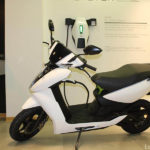We measure the driving ranges of 15 of the most popular all-electric vehicles
The advantages of electric vehicles are many. Whereas gasoline-powered vehicles transform only 17%–21% of the energy contained in the gasoline to drive the wheels, electric vehicles convert more than 77% of their battery energy to run the wheels.
Electric vehicles are good for the atmosphere because they release no tailpipe pollutants, and the electricity used to drive them can come from hydro, nuclear, solar or wind power, none of which contribute pollutants to the air. Electric vehicles have better torque and therefore provide greater acceleration. Electric vehicles are quiet and need less maintenance as compared to internal combustion engines.
So, if electric vehicles are so fine, why aren’t more people driving them? The answer can be condensed in two words: “range anxiety.”
What is “range anxiety”?
“Range anxiety” is the anxiety that an electric vehicle won’t have adequate range to reach its destination, and that its passengers would be deserted. The word was first used in a September 1997 article by Richard Acello in the San Diego Business Journal.
The phrase must have struck a chord because, on July 6, 2010, General Motors filed to trademark the term, declaring as their resolution, “promoting public awareness of electric vehicle capabilities”. In 2013, the Norwegian equal of “range anxiety”, rekkeviddeangst, took a second place on a list of Norwegian “words of the year” published by the Norwegian Language Council.
In 2016, a study carried by researchers at MIT and the Santa Fe Institute revealed that most travels and daily trips are well inside the range of an electric vehicle and that 87% of the vehicles on the street could be substituted by an electric vehicle without requiring to recharge during the day.
Approaches to beat range anxiety include:
- Formation of extensive charging infrastructure
- Improvement of higher battery capacity
- Use of battery swapping technology, which is usually used in warehouses on forklift trucks
- Use of range extenders, which can contain fuel cells or internal combustion engines
- Making of highly accurate range prediction and navigation applications.
The normal range of a gas-powered vehicle is 300–400 miles (400-600 km). Keeping that in mind, let’s take into consideration the ranges provided by today’s most popular all-electric vehicles.
1. 2019 Audi e-tron

- Acceleration (0-60mph): 5.7 seconds
- Top speed: 124 mph (200 km/h)
- Range: 204 miles (328 km)
- Seating: 5
- Starting price: $74,800
Audi’s initial all-electric vehicle, the e-tron is a luxury SUV that also provides all-wheel drive and has towing ability.
2. BMW i3

- Acceleration (0-60mph): 8 seconds
- Top Speed: 93 mph (150 km/h)
- Range: 153 miles (246 km)
- Seating: 4
- Starting price: $44,450
For the i3, BMW is proposing a voluntary gasoline-powered range extender engine that is the same 647 cc two-cylinder gasoline engine employed in the BMW C650 GT motorcycle. It owns a 2.4 gallon (9 L) fuel tank.
The range extender engine begins when the battery drops to a specific point, then functions as a generator to generate electricity. The i3’s range can be stretched from 80 to 100 miles (130–160 km) to 150 to 190 miles (240–300 km). The range-extender choice costs an extra $3,850 in the U.S., €4,490 in the Netherlands and €4,710 in France.
3. 2019 Tesla Model S

- Acceleration (0-60mph): 3.7 s (Long Range), 2.4 s (Performance)
- Top speed: 155 mph (249 km/h) (Long Range), 163 mph (262 km/h) (Performance)
- Range: 368 miles (593 km) (Performance), 370 miles (595 km) (Long Range)
- Seating: 5 (+2 short children)
- Starting price: $86,200 (Long Range)
The Tesla Model S is a complete-electric 5-passenger hatchback. Its duo of electric motors produces a huge amount of torque, allowing the Model S to outpace just about anything on the road.
4. 2019 Tesla Model X

- Acceleration (0-60mph): 4.4 s (Long Range), 2.7 s (Performance),
- Top speed: 155 mph (249 km/h) (Long Range), 163 mph (262 km/h) (Performance)
- Range: 305 miles (491 km) (Performance AWD), 328 miles (528 km) (Long Range AWD)
- Seating: 5-7
- Starting price: $98,200
The 3-row Tesla Model X SUV will let you to carry around seven friends or a lot of stuff, and it moves from 0 to 60 mph in 2.7 seconds.
5. 2019 Tesla Model 3

- Acceleration (0-60mph): 4.4 s (Long Range), 3.2 s (Performance)
- Top speed: 145 mph (233 km/h) (Long Range), 162 mph (261 km/h) (Performance),
- Range: 310 miles (500 km) (Performance), 348 miles (560 km) (Long Range AWD)
- Seating: 5
- Starting price: $45,700 (Long Range)
Tesla’s “car for the masses,” that is, if you have an extra $45,700 lying around, is the minimum and least costly Tesla. It attained a 5-star safety rating from the National Highway Traffic and Safety Administration (NHTSA).
6. Hyundai Kona Electric

- Acceleration (0-60mph): 6.4s
- Top speed: 104 mph (167km/h)
- Range: 292 miles (470 km)
- Seating: 5
- Starting price: $36,450
Constructing on its popular gas-powered Kona subcompact SUV, Hyundai has built a really multipurpose car in which to get around.
7. 2020 Kia Soul EV

- Acceleration: (0-60mph): 11.2 s
- Top speed: 90 mph (145 km/h)
- Range: 243 miles (391 km)
- Seating: 5
- Starting Price: $35,000
Kia did a massive range increase between the 2019 model, which only achieved 111 miles, compared to the 2020 model which has a range of 243 miles.
8. 2020 Mercedes-Benz EQC

- Acceleration (0-60mph): 4.9 s
- Top speed: 112 mph (180 km/h)
- Range: 220 miles (354 km)
- Seating: 5
- Starting price: $67.900
The EQC’s two electric motors offer all-wheel drive, and the base model comes with satellite radio, sunroof, a quality sound system, power liftgate, rain-sensing wipers, rear side-window sunshades, rear air suspension, heated seats, and LED headlights with active high beam assist.
9. 2019 Kia Niro EV (e-Niro)

- Acceleration (0-60mph): 7 s
- Top speed: 96 mph (155 km/h)
- Range: 239 miles (385 km)
- Seating: 5
- Starting price: $37,500
Kia’s automobile/SUV gas-powered Niro was already all the rage, and the all-electric version should be accepted as well.
10. 2019 Chevrolet Bolt EV

- Acceleration (0-60mph): 6.5 s
- Top Speed: 93 mph (150 km/h)
- Range: 238 miles (383 km)
- Seating: 5
- Starting price: $37,495
The Bolt was the first all-electric vehicle with a range of more than 200 miles and a price tag of below $40,000.
11. Hyundai Ioniq Electric

- Acceleration(0-60mph): 9.9 s
- Top speed: 115 mph (185 km/h)
- Range: 105–155 miles (169–250 km)
- Seating: 4
- Starting price: $30,315
The Hyundai Ioniq Electric is also available in hybrid and plug-in hybrid versions, but all varieties are only obtainable in select markets.
12. Ford Focus Electric

- Acceleration (0-60mph): 9.9 seconds
- Top speed: 84 mph (135 km/h)
- Range: 115 miles (185 km)
- Seating: 5
- Starting price: $29,200
The U.S. Environmental Protection Agency positions the Focus Electric as the most fuel-efficient car sold in the U.S.
13. 2019 Jaguar I-Pace

- Acceleration (0-60mph): 4.8 s
- Top speed: 124 mph (200 km/h)
- Range: 234 miles (377 km)
- Seating: 5
- Starting price: $69, 850
While it doesn’t look like a typical SUV, the I-Pace can do off-road.
14. 2019 Nissan Leaf Plus

- Acceleration (0-60mph): 6.5 s
- Top speed: 93 mph (150 km/h)
- Range: 226 miles (364 km)
- Seating: 5
- Starting price: $37,445
Newly introduced in 2019, this new Leaf has 214 horsepower.
15. Volkswagen e-Golf

- Acceleration (0-60mph): 10.4 seconds
- Top speed: 90 mph (145 km/h)
- Range: 186 miles (300 km)
- Seating: 5
- Starting price: $31,895
Volkswagen’s response to the Nissan Leaf and the Tesla Model 3, but it may give you range anxiety.



[…] automaker can walk industrial water against Tesla, as the whole automotive industry hinges to all-electric and sustainable […]
[…] YOU MAY LIKE: Is “Range Anxiety” Preventing You From Buying an All-Electric Vehicle? […]